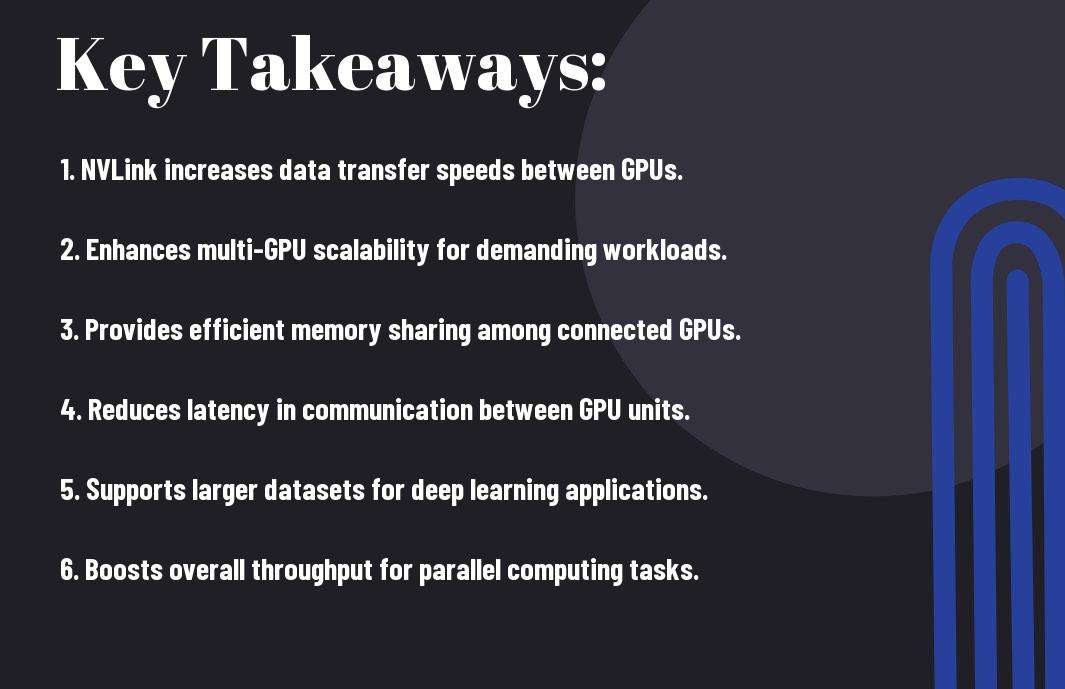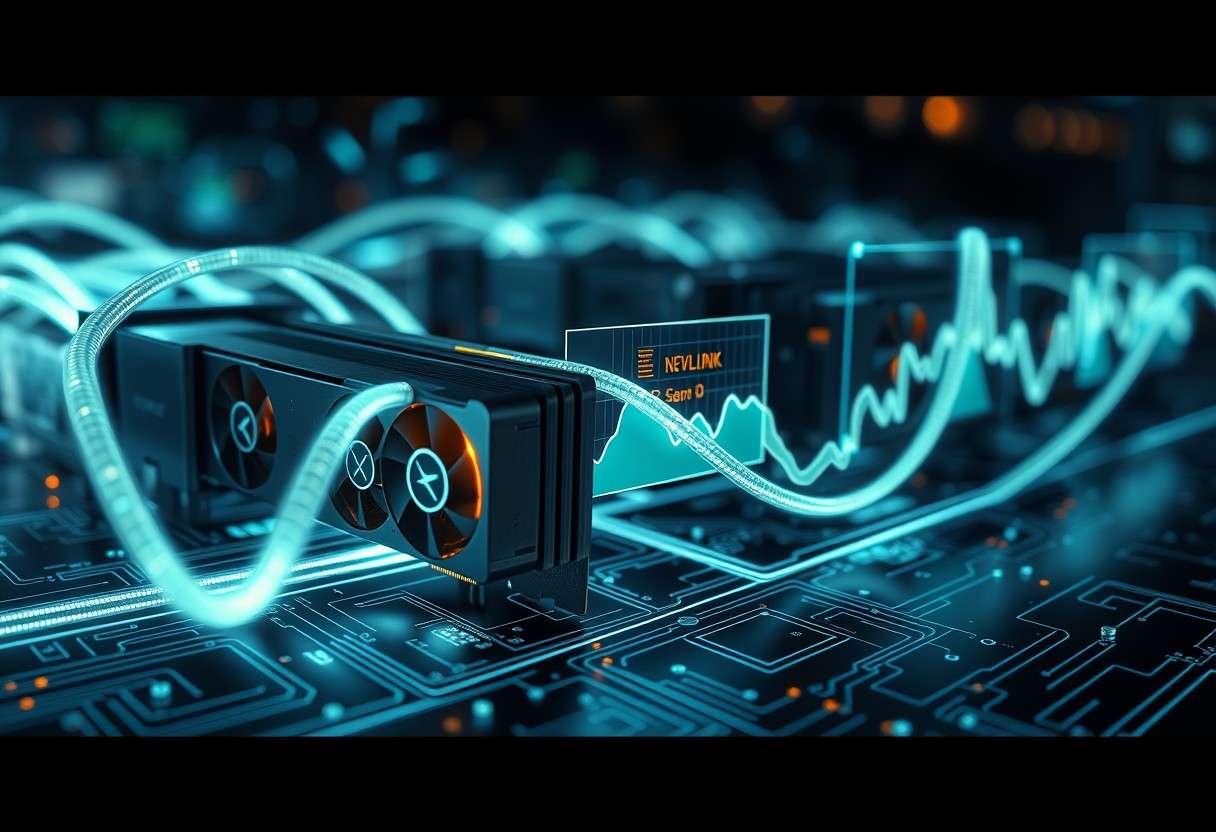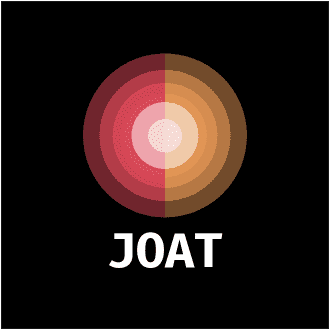It’s crucial for you to understand how NVLink can significantly improve your GPU performance and overall system throughput. This advanced interconnect technology allows for high-speed data transfer between GPUs, reducing bottlenecks and enabling seamless collaboration in multi-GPU setups. By leveraging NVLink, you can maximize the efficiency of your hardware and tackle demanding tasks like gaming, AI, and data analytics more effectively. In this blog post, we will explore the vital functions of NVLink and how it can elevate your computing experience to the next level.
Key Takeaways:
- High-Speed Communication: NVLink provides a high-bandwidth connection between GPUs, significantly improving data transfer rates compared to traditional PCIe interfaces.
- Scalability: NVLink facilitates scalable multi-GPU configurations, allowing systems to easily expand performance through additional GPUs without compromising throughput.
- Enhanced Memory Access: With NVLink, GPUs can access each other’s memory directly, enabling larger datasets to be processed more efficiently, particularly in complex computational tasks.
- Improved Resource Utilization: NVLink enables better resource sharing between GPUs, resulting in higher performance for parallel processing workloads and improved overall system efficiency.
- Support for AI and Deep Learning: The architecture of NVLink is particularly beneficial for AI and deep learning applications, allowing for faster model training and inference due to its superior throughput and communication capabilities.


Understanding NVLink
For anyone looking to enhance their GPU performance and throughput, understanding NVLink is crucial. NVLink is NVIDIA’s high-speed interconnect technology that enables faster communication between GPUs and other processing units like CPUs. This technology leverages an advanced architecture to facilitate bandwidth-intensive tasks, which are commonly required in machine learning, artificial intelligence, and massive data processing scenarios. By employing NVLink, you can significantly improve the data transfer rates between multiple GPUs, allowing for more efficient processing and lower latency. You can learn more about how NVLink contributes to enhanced performance in large language models by checking out NVIDIA NVLink and NVIDIA NVSwitch Supercharge Large ….
Definition and Overview
NVLink represents a departure from traditional PCIe connections, providing a robust framework for multi-GPU systems. This interconnect technology allows for a higher bandwidth compared to previous standards, facilitating better communication between GPUs. By minimizing the bottleneck typically posed by PCIe lanes, NVLink creates a more dynamic environment for tasks such as parallel processing, rendering, and high-performance computing. This makes it a foundational element in systems that require significant computational power.
Essentially, NVLink works by connecting multiple GPUs within a server architecture, allowing them to share memory and workload seamlessly. This integration leads to an enhanced throughput, making it particularly valuable for users of complex simulations, deep learning frameworks, and other applications that demand extensive computing capabilities. It positions itself as a critical technology for your performance enhancement pursuits.
History and Development of NVLink
Any discussion on NVLink wouldn’t be complete without exploring its history and development. The technology was first introduced in 2016 as a part of NVIDIA’s Pascal architecture, aiming to revolutionize the way GPUs communicate. Initially designed for use in data centers and supercomputing, NVLink has since evolved to become integral in various applications ranging from AI to gaming. Its adoption of a scalable architecture has allowed it to maintain relevance across subsequent GPU generations, including Volta and Ampere.
This forward-thinking design combines its advanced capabilities with an ever-increasing scalability factor, meaning it can accommodate the growing demands of modern computing tasks. Through a series of iterative improvements, NVIDIA has continually refined NVLink’s architecture to ensure enhanced reliability and performance, adapting to the needs of both developers and users alike.
Key Features of NVLink
With the benefits that NVLink brings to the table, you will undoubtedly want to explore its key features in detail. **NVLink** provides a suite of compelling characteristics that elevate GPU performance and throughput, such as:
- High Bandwidth: NVLink delivers bandwidth that significantly exceeds that of traditional PCIe connections.
- Scalability: The technology is scalable, allowing you to connect multiple GPUs seamlessly.
- Low Latency: NVLink minimizes communication latency, enhancing the speed of data transfer.
- Unified Memory Access: You can share memory across GPUs, simplifying the programming model.
- Compatibility: NVLink is compatible with both GPUs and CPUs, providing flexibility in system architecture.
Recognizing the potential of NVLink opens up new horizons for your high-performance computing projects, ensuring that you can tackle complex tasks with efficiency.
For instance, the adaptability of NVLink allows it to be implemented in various configurations, whether in data-center environments or workstations. You can harness its large bandwidth capability when running multiple GPUs in parallel to accelerate workloads significantly. This versatility is complemented by advanced features that ensure data integrity and security during transmission, maintaining your operational standards. Recognizing the innovative potential of NVLink can lead to vast improvements in your computational strategies and execution.
NVLink Architecture
One of the key innovations in modern GPU performance optimization is NVLink, NVIDIA’s high-speed, direct GPU-to-GPU interconnect technology. This architecture enhances the data communication capabilities between GPUs, allowing them to work collaboratively more efficiently than ever before. NVLink supports multiple GPUs within a single system, significantly increasing throughput and overall performance in computational tasks.
NVLink vs. PCIe: A Comparative Analysis
NVLink and PCIe are both vital for GPU connectivity, but they serve different purposes and exhibit distinct characteristics. In the table below, you’ll find a comparative analysis of their features:
Comparison of NVLink and PCIe
| Feature | NVLink |
|---|---|
| Bandwidth | Higher (up to 300 GB/s) |
| Latency | Lower compared to PCIe |
| Scalability | Better for multi-GPU setups |
| Compatibility | Limited to NVIDIA GPUs |
| Cost | Generally higher implementation costs |
NVLink offers a significant **advantage** over PCIe by providing a **higher bandwidth** and **lower latency**, necessary for applications that require high-speed data transfers. Additionally, its **scalability** for multi-GPU configurations makes it appealing for data centers and complex computational tasks, even though it might come with a higher **cost** and is limited to NVIDIA-compatible systems.
Topology and Bandwidth Considerations
With NVLink, the architecture allows for a unique **topological layout** that optimizes bandwidth usage among multiple GPUs. Unlike traditional PCIe connections, NVLink can create a more dynamic routing system that enhances direct communication between GPUs, leading to greater efficiency in data-heavy applications. This is particularly critical in realms like deep learning and AI, where data throughput can be a bottleneck in processing performance.
Understanding the **bandwidth considerations** involved is crucial for anyone looking to build a high-performance computing system. NVLink’s ability to deliver substantial **dedicated bandwidth** ensures that inter-GPU communication does not become a latency point, allowing GPUs to harness their full computational power without being hindered by data transfer constraints.
Scalability and Integration with CPU/GPU Systems
Integration of NVLink in CPU/GPU systems is a remarkable feature that enhances performance capabilities. By allowing multiple GPUs to connect efficiently, NVLink facilitates a **scalable architecture** where you can expand your resources without significant reconfiguration. The seamless interaction between CPUs and GPUs maximizes computational throughput and ensures that **data transfer** does not become a limiting factor.
NVLink creates a robust framework for scaling your systems as needed, giving you the flexibility to adapt to growing computational demands. This **scalability** ultimately brings you more power and efficiency when tackling complex workloads, positioning your configurations at the cutting edge of technology in demanding fields such as machine learning, scientific simulations, and graphics rendering.
Enhancements to GPU Performance
Unlike traditional graphics processing units (GPUs) that operate independently, NVLink allows multiple GPUs to communicate with each other more effectively. This interconnect technology enhances the performance of your GPU setups by significantly elevating the throughput of data between them. The result is a more cohesive system that maximizes the potential of each GPU, making it ideal for computationally intensive applications like deep learning, 3D rendering, and scientific computations.
Improved Memory Bandwidth
For you to truly grasp the advantages of NVLink, it is necessary to understand how it contributes to the improved memory bandwidth. With NVLink, memory access speeds are drastically increased, enabling higher bandwidth compared to traditional PCIe connections. This improved memory bandwidth allows your GPUs to share data more rapidly and efficiently, removing bottlenecks that can slow down your workloads. Consequently, applications that require vast amounts of data can operate smoother and faster.
Moreover, this elevated memory bandwidth is particularly beneficial when working with large datasets or complex simulations. As you push the limits of your GPU capabilities, NVLink ensures that your system can handle the data flow, so you won’t be left waiting for memory to catch up to processing. This feature is instrumental in enhancing overall GPU performance, ultimately allowing for better results and higher output rates in your projects.
Increased Parallel Processing Capabilities
Parallel processing is at the core of GPU functionality, and NVLink takes this concept to the next level. With NVLink, your setup can tap into the combined power of multiple GPUs, leading to significant gains in processing capabilities. This means that your GPU architectures can share workloads efficiently, allowing for more comprehensive processing of tasks — a game-changer for applications such as AI, machine learning, and real-time simulations.
The increased parallel processing capabilities offered by NVLink help you to tackle extremely demanding tasks that would overwhelm a single GPU. With multiple units working in harmony, you can expect not only improved performance but also quicker turnaround times on complex workloads. By distributing the processing load across GPUs, NVLink ensures that your resources are maximized fully, allowing for even greater advancements in your projects.
Effects on Ray Tracing and AI Workloads
Increased processing power from NVLink has a profound impact on workloads such as ray tracing and artificial intelligence (AI). These tasks often require immense computation due to their complex nature. With NVLink enabling multiple GPUs to collaborate seamlessly, you can receive real-time feedback and rendering, enhancing the overall quality of your visual outputs. This interconnectivity elevates your gaming experience, enriching both graphics fidelity and fluidity.
Furthermore, as you examine deeper into AI workloads, the need for quick data processing becomes exponentially crucial. NVLink empowers your GPUs to work together, effectively leveraging their combined resources to expedite training processes and model evaluations. This not only accelerates your workflow but also yields better model accuracy and performance, translating to more effective AI solutions.
Bandwidth plays a critical role in driving the performance needed for these advanced workloads. When GPUs communicate without delay through NVLink’s superior bandwidth, you eliminate the risk of latency that can hinder your productivity. This connectivity ensures that whether you are rendering stunning visuals or training sophisticated AI models, your system remains agile and responsive, greatly enhancing your overall experience.
Impact on Throughput
Many advancements in computing have revolved around enhancing throughput, and NVLink is at the forefront of this evolution. It addresses the key limitations of traditional PCIe connections by providing a dedicated pathway for data transfer that can significantly increase bandwidth. This enhanced connectivity allows your GPUs to communicate with one another more efficiently, leading to improved performance in a variety of workloads. When you utilize systems that incorporate NVLink, you will find that the overall throughput is greatly improved, enabling your applications to operate smoothly in data-intensive scenarios.
Multi-GPU Configurations and Throughput
With NVLink, multi-GPU configurations are able to achieve unprecedented levels of performance. This technology allows multiple GPUs to work in tandem, maximizing the combined power that can be delivered to your computational tasks. As a result, you will notice a substantial increase in throughput and improved processing capabilities when rendering graphics or running complex simulations. By enabling tighter synchronization and increased data sharing, NVLink allows your system to fully utilize the hardware resources at your disposal.
With such enhancements, you can also expect reduced latency when transferring large datasets between GPUs. This means that tasks that rely on real-time computation, like deep learning and scientific simulations, will benefit immensely from the swift interconnectivity facilitated by NVLink. The overall efficiency of your systems will improve, as content is moved seamlessly between GPUs, ensuring that there are minimal bottlenecks in your workflows.
Real-Time Data Processing Enhancements
For applications that demand real-time data processing, NVLink provides a significant advantage. By enabling higher bandwidth communication between GPUs, it allows you to effortlessly manage larger datasets and make quicker decisions based on incoming information. This is especially beneficial for tasks that operate within tight time constraints, such as video rendering and live data analytics. With NVLink, the performance is not only enhanced; it becomes more scalable, as you can add additional GPUs without compromising throughput or response times.
The ability to handle real-time data with high throughput enabled by NVLink leads to improved performance in various sectors, such as finance, healthcare, and autonomous vehicles. Organizations that require instant insights from large data streams will see a tangible benefit from utilizing NVLink-equipped systems, as decisions can be made faster and more efficiently.
Throughput in AI and Deep Learning Applications
The throughput enhancements offered by NVLink also play a critical role in AI and deep learning applications. These fields often require extensive data processing and enormous computational power, making high throughput vital for effective training and inference stages. With the improved connectivity and bandwidth that NVLink provides, you can expect faster model training times and reduced latency during inference, enabling your AI solutions to operate at their optimal levels.
A thorough understanding of how NVLink impacts throughput in AI applications is vital for any professional in the field. When you leverage multitudes of data with multiple GPUs linked via NVLink, each GPU’s ability to share information and collaborate reduces the time needed to derive insights or predictions. This synergy is crucial in achieving cutting-edge performance in machine learning models and can ultimately lead to innovations and breakthroughs in your projects.
Deployments and Applications of NVLink
All around the world, organizations are discovering the transformative potential of NVLink, enhancing the capabilities of their GPU deployments. Whether in data centers, gaming, or scientific research, NVLink is increasingly being integrated into various applications to unlock greater performance and throughput. For further understanding about the concept of NVLink and its role in optimizing multiple NVIDIA GPU performance, you can refer to Can you explain the concept of NVLink and how it relates ….
Use in High-Performance Computing (HPC)
For organizations focused on high-performance computing (HPC), NVLink offers a groundbreaking shift in data transfer capabilities between GPUs. This technology allows multiple GPUs to communicate with one another at incredible speeds, drastically reducing data bottlenecks that are prevalent in traditional setups. With each GPU capable of accessing memory resources faster, you can tackle complex simulations and computational tasks with higher efficiency and speed.
Moreover, NVLink enhances the scaling of applications across multiple GPUs. For instance, in machine learning and AI workloads, where vast amounts of data need to be processed simultaneously, NVLink can significantly improve your model training times. The seamless integration allows these tasks to be distributed more evenly across your GPU resources, enabling you to achieve results quicker and more effectively.
Applications in Graphics Rendering
To understand NVLink’s impact on graphics rendering, consider its ability to facilitate real-time rendering experiences that were previously unattainable. In environments where graphics demand is high, such as video game design or 3D modeling, NVLink enables multiple GPUs to work in tandem. This results in higher frame rates and better visual fidelity, allowing for unparalleled user experiences.
Applications that rely on rendering often face challenges related to memory limitations and data throughput. NVLink mitigates these issues by allowing GPUs to share memory space more effectively. This means that you no longer have to worry about your rendering pipeline being hindered by data bottlenecks, ultimately resulting in faster production times for graphics-heavy applications.
Applications in the graphics rendering field are extensively diverse, ranging from AAA game development to architectural visualization. The ability to use multiple GPUs interconnected via NVLink allows artists and developers to create intricate scenes with detailed textures, complex lighting, and extensive particle systems while maintaining smooth interactions and rendering speed.
Impact on Scientific Research and Simulations
Scientific calculations and simulations rely heavily on intense computational power. Scientific research often requires iterative calculations across large datasets, which can be crippling for traditional setups. With NVLink, however, you can expect a notable boost in speed and performance. This technology specializes in linking GPUs, allowing them to effectively coordinate on complex scientific models and simulations without facing data transfer bottlenecks.
The contribution of NVLink extends beyond mere performance metrics; it can catalyze breakthroughs in scientific discovery. By enabling faster collaboration and data interpretation, researchers can tackle larger, more intricate models across various fields, from climate simulations to genetic research. This is critical as the demands for real-time data processing in scientific contexts continue to grow.
For instance, with the integration of NVLink in computational studies, simulations that once took days may now only take hours, fostering a culture of innovation and rapid problem-solving. This is especially crucial in fields like drug discovery, where time is often of the essence, allowing faster identification and testing of potential compounds.
Future of NVLink and GPU Technology
Unlike traditional interconnect technologies, NVLink is poised to play a pivotal role in addressing the increasing demands for high-performance computing. The emergence of artificial intelligence (AI), machine learning, and complex simulations has underscored the need for faster data transfer and improved bandwidth between GPUs. As you look towards the future, it’s clear that NVLink will continue to advance, potentially reshaping how workloads are processed in data centers and personal computing. The integration of NVLink with next-generation GPU architectures can enhance performance dramatically, enabling you to handle more intricate tasks with greater efficiency.
Emerging Trends and Innovations
For you, keeping an eye on emerging trends and innovations in the NVLink space is necessary for staying ahead in the tech landscape. Current developments suggest that future iterations of NVLink may incorporate enhanced bandwidth capabilities, allowing for seamless scalability in GPU clusters. This means you could leverage multiple GPUs more effectively without bottlenecks, ensuring that your applications run smoothly even under heavy computational loads.
Additionally, you might see NVLink’s integration with other technologies such as PCIe 5.0, further improving data transfer rates. This hybrid architecture could lead to more versatile setups that cater to various workloads, providing you with more flexibility and performance in everything from gaming to scientific research.
Predictions for Future NVLink Capabilities
The evolution of NVLink suggests that we can expect a significant boost in throughput as GPU technology continues to progress. Future NVLink versions may not only provide higher bandwidth but also improve latency times, allowing for quicker data accesses. This could enable you to tackle larger datasets and run more complex simulations while maintaining stability and speed.
Furthermore, as machine learning and AI applications become more demanding, NVLink’s role is likely to expand. The architecture’s capabilities could evolve to support multi-GPU setups more efficiently, aiding in optimizations that facilitate rapid model training and processing, which are necessary for your projects.
Technology is advancing at a remarkable pace, and these predictions suggest that NVLink will form a critical component in the optimized computing landscape of tomorrow. The synergy between NVLink and upcoming GPU cores can pave the way for highly efficient computing environments, allowing you to harness the full power of parallel processing and its associated benefits.
Compatibility with Quantum Computing
An intriguing aspect of NVLink’s future lies in its potential compatibility with quantum computing technologies. As quantum computing progresses from experimental to practical applications, you may find that NVLink plays a crucial role in bridging the gap between classical and quantum systems. This synergy can enhance data handling capabilities and provide the necessary infrastructure for hybrid computing solutions.
Furthermore, by integrating NVLink with quantum computing, you could see improved communication between classical GPUs and quantum processors. This could allow for distributed processing that combines the strengths of both technologies, creating a robust computing environment designed to solve complex problems that are currently beyond reach.
Future advancements may lead to standardized protocols that ensure seamless interoperability between your classical systems and emerging quantum devices. As NVLink evolves, you might discover new ways to enhance your computational prowess and address challenging tasks that demand cutting-edge technology. This shift could provide you with unprecedented opportunities to push the boundaries in both research and practical applications.
Summing up
Ultimately, NVLink plays a crucial role in enhancing GPU performance and throughput by providing a high-bandwidth, low-latency interconnect that enables seamless communication between multiple GPUs. This technology allows you to harness the full potential of your GPU setup, whether for deep learning, scientific simulations, or data analytics. By facilitating faster data exchange among GPUs, NVLink minimizes bottlenecks that could hinder the performance of your applications, ensuring that your workloads are executed efficiently and swiftly. Furthermore, this robust interconnect enables scaling your computational resources, allowing you to tackle larger problems and achieve remarkable results.
In addition to boosting performance, NVLink also enhances memory pooling capabilities, which effectively increases the available memory for large datasets and complex models. By leveraging this feature, you can optimize your workflows, making it easier to manage demanding tasks without compromising on speed or efficiency. Thus, as you consider your GPU architecture, incorporating NVLink into your strategy can significantly alter how you experience high-performance computing, marking a pivotal transition toward achieving your computational objectives.
FAQ
Q: What is NVLink and how does it differ from traditional PCIe connections?
A: NVLink is a high-speed, low-latency GPU interconnect technology developed by NVIDIA. Unlike traditional PCIe connections, which often have limited bandwidth, NVLink can provide significantly higher throughput between multiple GPUs. This means data can be transferred between GPUs much more quickly, enabling faster performance for compute-intensive tasks such as deep learning, scientific simulations, and high-performance computing (HPC). NVLink allows for multiple GPUs to operate more cohesively, effectively acting as a single logical unit, which greatly enhances throughput.
Q: How does NVLink improve data sharing among GPUs during parallel processing?
A: NVLink facilitates faster and more efficient data sharing among GPUs by allowing them to communicate with each other directly rather than relying solely on the CPU and system memory. This direct communication reduces latency and increases bandwidth, which is particularly beneficial in situations where large datasets need to be exchanged frequently. Consequently, algorithms that require collaboration between multiple GPUs, such as deep learning frameworks, can achieve significant speedups because the GPUs can work together more seamlessly and efficiently.
Q: What kind of workloads benefit the most from NVLink technology?
A: Workloads that require extensive parallel processing, such as machine learning, artificial intelligence (AI), and large-scale simulations, benefit the most from NVLink. These types of tasks often involve large datasets that need to be processed and modified in real-time by multiple GPUs. NVLink’s high bandwidth and low latency ensure that these GPUs can access and share data quickly, resulting in reduced training times for machine learning models and enhanced performance for real-time simulations. Moreover, applications in fields such as 3D rendering, video editing, and scientific modeling also see substantial improvements when utilizing NVLink.
Q: Can NVLink support more than two GPUs, and what implications does this have for performance?
A: Yes, NVLink can support configurations with more than two GPUs, enhancing overall performance significantly. In fact, NVLink allows for multi-GPU setups with higher bandwidth connections that enable more effective resource utilization. By allowing multiple GPUs to communicate efficiently, NVLink enables shared memory access and reduces the bottleneck that can occur with standard PCIe connections. This multi-GPU capability allows for scaling performance linearly up to a certain point, making it possible to handle increasingly demanding tasks without suffering from diminishing returns.
Q: How does NVLink impact memory access and utilization in GPU-accelerated tasks?
A: NVLink enhances memory access and utilization by allowing GPUs to share memory pools effectively. In a traditional setup, each GPU has its dedicated memory, which can become a bottleneck when attempting to share large datasets across multiple GPUs. With NVLink, GPUs can access each other’s memory more efficiently, which is particularly advantageous for tasks requiring the processing of large data or complex models. By allowing for this shared memory architecture, NVLink improves operational efficiency and overall throughput, resulting in quicker computation times and better performance in GPU-accelerated applications.







